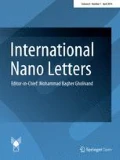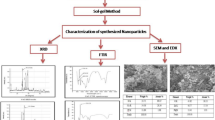Abstract
To raise the need of new precursors in the synthesis of NiO nanoparticles, mononuclear nickel(II) Schiff base complexes, viz. Ni(salbn) and Ni(Me2-salpn), were employed as precursor in solid-state thermal decomposition. Structure, purity and morphology of these nanoparticles have been examined by Fourier transform infrared spectroscopy, X-ray powder diffraction, scanning electron microscopy and transmission electron microscopy (TEM). TEM analysis reveals that the synthesized nanoparticles have cubic particles with an average diameter of around 5–15 nm. This method is simple, less costly, and fast and safe for production of NiO nanoparticles in industrial applications.
Similar content being viewed by others
Background
Recently, nickel(II) Schiff base complexes have been widely investigated not only for their interesting structures and properties [1, 2], but also for their use as precursor for preparation of nickel oxide nanoparticles [3]. Then, considerable interest has been grown on the preparation and characterization of NiO nanoparticles via thermal decomposition of complexes for their unique applications and properties [4, 5]. Among the transition metal oxides, nickel oxide has attracted much attention due to its properties and applications [6, 7]. Presently several methods, viz. hydrothermal, thermal decomposition, sol–gel, solvothermal and sonochemical are available to prepare NiO nanoparticles [8–10]. However, thermal decomposition method is a better choice as it makes control process conditions, particle size, particle crystal structure and purity possible [3–5]. Salavati-Niasari et al. have reported the synthesis of NiO nanoparticles [3] using four coordinated nickel(II) Schiff base complex Ni(salen) while Farhadi group have synthesized NiO nanoparticles by solid-state thermal decomposition of octahedral nickel(II) complexes, viz. [Ni(en)3](NO3)2 [4] and [Ni(NH3)6](NO3)2 [5].
Recently, our group has synthesized nickel oxides nanoparticles via thermal decomposition method of nickel Schiff base complexes [11–13]. Herein, we have reported the synthesis of NiO nanoparticles by solid-state thermal decomposition of Ni(II) Schiff base complexes, Ni(salbn) (1) and Ni(Me2-salpn) (2) (Scheme 1).
Experimental
Materials and characterization
All reagents and solvents for synthesis and analysis are commercially available and used as received. Elemental analyses are carried out using a Heraeus CHN-O-Rapid analyzer. X-ray powder diffraction (PXRD) pattern of the nanoparticles is recorded on a Panalytical Empyran with Cu–Kα radiation in the range 2θ = 0°–140°. Fourier transform infrared spectroscopy (FTIR) spectra are recorded as a KBr disk on a Perkin–Elmer FTIR spectrophotometer. Scanning electron microscopy (SEM) images are collected on Philips XL-30ESEM. Transmission electron microscopy (TEM) images are recorded on a JEOL JEM 1,400 instrument with an accelerating voltage of 120 kV.
Preparation of Ni(salbn) (1) and Ni(Me2-salpn) (2) complexes
To obtain a dark red precipitates of complexes, a methanol solution (20 mL) of salbn or Me2-salpn (2 mmol) was added to methanol solution (20 mL) of Ni(NO3)2·6H2O (2 mmol). The resulting solution was stirred for 2 h. The product was removed by filtration, washed with cooled ethanol and dried at room temperature for several days. Anal. calcd. for C18H18NiN2O2 (1): C, 61.24; H, 5.13 and N, 7.93 %; found C, 61.36; H, 5.23 and N, 7.86 %. FTIR (cm−1): 1,624 (C=N). Anal. calcd. for C19H20NiN2O2 (2): C, 62.17; H, 5.49 and N, 7.63 %; found C, 62.26; H, 5.53 and N, 7.76 %. FTIR (cm−1): 1,610 (C=N).
Preparation of NiO nanoparticles
New precursors 1 and 2 are loaded on to a platinum crucible and placed in an oven to be heated at a rate of 10 °C/min in air. Nanoparticles of nickel oxide are synthesized at 450 °C after 3.5 h. To remove any impurities, the final products are washed with ethanol and dried at room temperature for 3 days.
Results and discussion
FTIR spectra
The FTIR spectra of the precursors 1 and 2 are shown in Fig. 1. The characteristic peaks at 1,624 in 1 and 1,610 cm−1 in 2 are attributed to the υ(C=N) stretchings [3–5] which disappeared in Fig. 2 with the appearance of new strong band at 418 cm−1 in nanoparticles prepared from 1 and at 420 cm−1 in nanoparticles prepared from 2, indicating the spinel structure of Ni–O [3–5]. The broad band at around 3,500 cm−1 in the spectrum of NiO nanoparticles is attributed to the adsorbed water on the external surface of the samples. Also, the H-OH bending vibration appears at about 1,640 cm−1 [3–5].
XRD patterns
Figure 3 shows the XRD patterns (0° < 2θ < 130°) of the nickel oxide nanoparticles prepared via solid-state thermal decomposition from nickel(II) Schiff base complexes 1 and 2. The powders showed the crystalline pattern, and according to standard nickel oxide pattern (JCPDS: 75-0197) [3–5], all diffraction peaks can be well indexed as face-centered cubic phase at about 2θ = 37°, 43°, 62°, 75° and 79°, which can be perfectly related to 111, 200, 220, 311 and 222 crystal planes, respectively. No obvious peaks of impurities were seen in the XRD pattern of NiO obtained by thermal decomposition. Moreover, the observed peaks are sharper and higher in intensity which confirmed the well crystallization of the prepared NiO nanoparticles. These results confirm that at 450 °C the complexes were decomposed completely to nickel oxide.
SEM and TEM images
The morphology and microstructure of the NiO nanoparticles have been investigated using SEM and TEM techniques. Figures 4 and 5 are the respective SEM and TEM images of the nanoparticles obtained from 1 and 2 which indicate their particle size around 10–15 nm. The particles are both spherical and cubic. The choice of nickel precursor and method is the main step in the synthesis of nickel oxide nanoparticles (Table 1). Although many different precursors and methods have been used for preparation of nickel oxide [3–5], this report is the scare report on the synthesis of NiO nanoparticles from nickel(II) Schiff base complexes [5–7].
Conclusions
Pure NiO nanoparticles having average size of 10–15 nm have been successfully prepared by solid-state thermal decomposition (at 450 °C for 3 h) of Ni(II) Schiff base complexes, viz. Ni(salbn) (1) and Ni(Me2-salpn) (2). This facile, inexpensive and nontoxic method may be useful for the preparation of other transition metal oxide nanoparticles.
References
Saha, S., Pal, S., Gomez-Garcia, C.J., Clemente-Juan, J.M., Harms, K., Nayek, H.P.: A ferromagnetic tetranuclear nickel(II) Schiff-base complex with an asymmetric Ni4O4 cubane core. Polyhedron 28, 1–5 (2014)
Saha, S., Kottalanka, R.K., Bhowmik, P., Jana, S., Harms, K., Panda, T.K., Chattopadhyay, S., Nayek, H.P.: Synthesis and characterization of a nickel(II) complex of 9-methoxy-2,3-dihydro-1,4-benzoxyzepine derived from a Schiff base ligand and its ligand substitution reaction. J. Mol. Struct. 1061, 26–31 (2014)
Ghaffari, A., Behzad, M., Pooyan, M., Amiri Rudbari, H., Bruno, G.: Crystal structures and catalytic performance of three new methoxy substituted salen type nickel(II) Schiff base complexes derived from meso-1,2-diphenyl-1,2-ethylenediamine. J. Mol. Struct. 1063, 1–7 (2014)
Ourari, A., Ouennoughi, Y., Aggoun, D., Mubarak, M.S., Pasciak, E.M., Peters, D.G.: Synthesis, characterization, and electrochemical study of a new tetradentate nickel(II)-Schiff base complex derived from ethylenediamine and 5′-(N-methyl-N-phenylaminomethyl)-2′-hydroxyacetophenone. Polyhedron 67, 59–64 (2014)
Khalaji, A.D.: Preparation and characterization of NiO nanoparticles via solid-state thermal decomposition of nickel(II) Schiff base complexes [Ni(salophen) and [Ni(Me-salophen)]. J. Clust. Sci. 24, 209–215 (2013)
Khansari, A., Enhessari, M., Salavati-Niasari, M.: Synthesis and characterization of nickel oxide nanoparticles from Ni(salen) as precursor. J. Clust. Sci. 24, 289–297 (2013)
Khalaji, A.D.: Preparation and characterization of NiO nanoparticles via solid-state thermal decomposition of Ni(II) complex. J. Clust. Sci. 24, 189–195 (2013)
Farhadi, S., Kazem, M., Siadatnasab, F.: NiO nanoparticles prepared via thermal decomposition of the bis(dimethylglyoximato)nickel(II) complex: a novel reusable heterogeneous catalyst for fast and efficient microwave-assisted reduction of nitroarenes with ethanol. Polyhedron 30, 606–613 (2011)
Farhadi, S., Roostaei-Zaniyani, Z.: Preparation and characterization of NiO nanoparticles from thermal decomposition of the [Ni(en)3](NO3)2 complex: a facile and low-temperature route. Polyhedron 30, 971–975 (2011)
Farhadi, S., Roostaei-Zaniyani, Z.: Simple and low-temperature synthesis of NiO nanoparticles through solid-state thermal decomposition of the hexa(ammine)Ni(II) nitrate, [Ni(NH3)6](NO3)2, complex. Polyhedron 30, 1244–1249 (2011)
Miao, F., Li, Q., Tao, B., Chu, P.K.: Fabrication of highly ordered porous nickel oxide anode materials and their electrochemical characteristics in lithium storage. J. Alloy. Compd. 594, 65–69 (2014)
Jlassi, M., Sta, I., Hajji, M., Ezzaouia, H.: Optical and electrical properties of nickel oxide thin films synthesized by sol–gel spin coating. Mater. Sci. Semicond. Process. 21, 7–13 (2014)
Wu, J., Xia, Q., Wang, H., Li, Z.: Catalytic performance of plasma catalysis system with nickel oxide catalysts on different supports for toluene removal: effect of water vapor. Appl. Catal. B 156–157, 265–272 (2014)
Capasso, L., Camatini, M., Gualtieri, M.: Nickel oxide nanoparticles induce inflammation and genotoxic effect in lung epithelial cells. Toxicol. Lett. 226, 28–34 (2014)
Zolgharnein, J., Shariatmanesh, T., Babaei, A.: Simultaneous determination of propanil and monalide by modified glassy carbon electrode with nickel oxide nanoparticles, using partial least squares modified by orthogonal signal correction and wavelet packet transform. Sens. Actuators B 197, 326–333 (2014)
Cheng, M.-Y., Ye, Y.-S., Chiu, T.-M., Pan, C.-J., Hwang, B.-J.: Size effect of nickel oxide for lithium ion battery anode. J. Power Sour. 253, 27–34 (2014)
Sankaranarayanan, K., Hakkim, V., Nair, B.U., Dhathathreyan, A.: Nanoclusters of nickel oxide using giant vesicles. Coll. Surf. A 407, 150–158 (2012)
Sekiya, K., Nagato, K., Hamaguchi, T., Nakao, M.: Morphology control of nickel oxide nanowires. Microelectron. Eng. 98, 532–535 (2012)
Wu, P., Sun, J.H., Huang, Y.Y., Gu, G.F., Tong, D.G.: Solution plasma synthesized nickel oxide nanoflowers: an effective NO2 sensor. Mater. Lett. 82, 191–194 (2012)
Xia, Q.X., Hui, K.S., Hui, K.N., Hwang, D.H., Lee, S.K., Zhou, W., Cho, Y.R., Kwon, S.H., Wang, Q.M., Son, Y.G.: A facile synthesis method of hierarchically porous NiO nanosheets. Mater. Lett. 69, 69–71 (2012)
Wang, L., Hao, Y., Zhao, Y., Lai, Q., Xu, X.: Hydrothermal synthesis and electrochemical performance of NiO microspheres with different nanoscale building blocks. J. Sol. State Chem. 183, 2576–2581 (2010)
Sub Kwak, B., Choi, B.-H., Ji, M.-J., Park, S.-M., Kang, M.: Synthesis of spherical NiO nanoparticles using a solvothermal treatment with acetone solvent. J. Ind. Eng. Chem. 18, 11–15 (2012)
Pilban Jahromi, S., Huang, N.M., Muhamad, M.R., Lim, H.N.: Green gelatine-assisted sol–gel synthesis of ultrasmall nickel oxide nanoparticles. Ceram. Int. 39, 3909–3914 (2013)
Sattarahmady, N., Heli, H., Dehdari Vais, R.: A flower-like nickel oxide nanostructure: synthesis and application for choline sensing. Talanta. 119, 207–213 (2014)
Khalaji, A.D., Nikookar, M., Das, D.: Co(III), Ni(II), and Cu(II) complexes of bidentate N, O-donor Schiff base ligand derived from 4-methoxy-2-nitroaniline and salicylaldehyde: synthesis, characterization, thermal studies and use as new precursors for metal oxides nanoparticles. J. Therm. Anal. Calorim. 115, 409–417 (2014)
Mehdizadeh, R., Sanati, S., Saghatforoush, L.A.: Preparation and characterization of nickel oxide nanostructures via solid state thermal decomposition approach. Synth. React. Inorg. Metal-Org. Nano-Metal Chem. 43, 466–470 (2013)
Bhattacharjee, C.R., Purkayastha, D., Chetia, J.R.: Surfactant-assisted low-temperature thermal decomposition route to spherical NiO nanoparticles. J. Coord. Chem. 64, 4434–4442 (2011)
Sun, Y., Chen, L., Meng, S., Wang, Y., Li, H., Han, Y., Wei, N.: Synthesis of NiO nanospheres with ultrasonic method foe supercapacitors. Mater. Sci. Semicond. Process. 17, 129–133 (2014)
Fereshteh, Z., Salavati-Niasari, M., Saberyan, K., Hosseinpour-Mashkani, S.M., Tavakoli, F.: Synthesis of nickel oxide nanoparticles from thermal decomposition of a new precursor. J. Clust. Sci. 23, 577–583 (2012)
Acknowledgments
A.D. Khalaji is grateful to the Council of Iran National Science Foundation and Golestan University for their financial support.
Author information
Authors and Affiliations
Corresponding author
Rights and permissions
This article is published under license to BioMed Central Ltd. Open Access This article is distributed under the terms of the Creative Commons Attribution License which permits any use, distribution, and reproduction in any medium, provided the original author(s) and the source are credited.
About this article
Cite this article
Khalaji, A.D., Das, D. Synthesis and characterizations of NiO nanoparticles via solid-state thermal decomposition of nickel(II) Schiff base complexes. Int Nano Lett 4, 117 (2014). https://doi.org/10.1007/s40089-014-0117-4
Received:
Accepted:
Published:
DOI: https://doi.org/10.1007/s40089-014-0117-4










